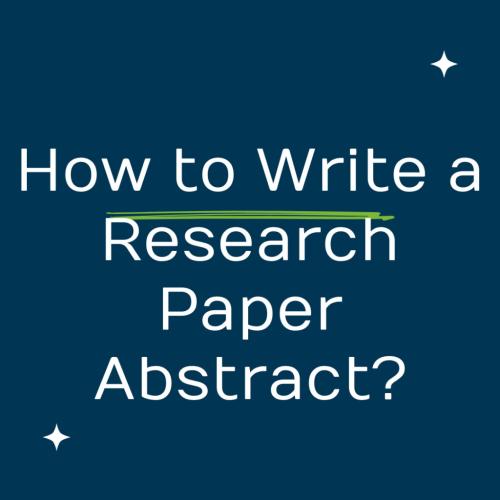How to Write an Effective Abstract: A Comprehensive Guide
An abstract serves as a concise summary of a research paper, helping readers quickly understand the scope and relevance of your work. It’s crucial for indexing in online databases and for enticing readers to delve deeper into your research. This guide will explore what an abstract is, the various types, and the steps to craft a compelling one. We will also provide a sample abstract to illustrate these points.
Key Takeaways:
An abstract succinctly summarizes the main points of a research paper, aiding readers in determining the paper’s relevance to their interests.
Typically 150–250 words, an abstract should be written after completing the full paper to ensure accuracy in summarizing the findings.
Essential components include the purpose of the research, methodology, results, and conclusions or implications.
What is an Abstract?
An abstract is a brief overview of a research paper, providing a snapshot of the study’s objectives, methods, results, and conclusions. Unlike excerpts, abstracts are original content written to encapsulate the essence of the full paper. They often contain keywords that help in indexing and searching within databases.
Elements of an Abstract
- Purpose: Clearly state the research question or problem and its significance.
- Methodology: Describe the methods and procedures used to conduct the research.
- Results: Summarize the key findings of the study.
- Conclusion: Highlight the implications of the results and any potential future research directions.
When to Write an Abstract
Despite appearing at the beginning of a paper, the abstract should be written last. This ensures that it accurately reflects the content of the paper. It is usually placed after the title page and acknowledgments but before the table of contents.
How to Write an Abstract
1. Complete Your Paper
Finish writing your research paper first. This allows you to provide a precise summary in the abstract.
2. Review Requirements
Check any specific guidelines or requirements for the abstract, such as word count or format, especially if submitting to a journal or for a project.
3. Know Your Audience
Understand who will be reading your abstract. Tailor the language and content to your audience’s level of expertise and interests.
4. Define the Problem
Clearly outline the problem your research addresses. Mention the scope of your study and the main argument or hypothesis.
5. Explain Methods
Briefly describe the research methods and approaches you used. Include any key procedures or evidence that supports your research.
6. Summarize Results
Provide a concise summary of the main findings. Highlight the most significant results if space is limited.
7. Conclude Effectively
End with a statement on the implications of your findings. Mention the significance of your research and any recommendations for future studies.
IMRaD Structure
Many scientific articles follow the IMRaD format, which stands for Introduction, Method, Results, and Discussion. Here’s a quick overview:
- Introduction: Outline the background and importance of the research.
- Method: Describe the research methods and procedures used.
- Results: Present the key findings.
- Discussion: Interpret the results, compare with existing studies, and suggest future research.
Tips for Writing an Abstract
- Stick to the word limit. Abstracts are usually between 100 and 250 words.
- Follow formatting guidelines: Adhere to specific requirements for your abstract.
- Be concise: Provide a summary of findings rather than details.
- Use keywords: Include terms from your paper to enhance searchability.
- Read other abstracts: Use them as examples for structure and style.
What to Avoid in an Abstract
- Avoid excessive citations: Do not extensively refer to other works.
- Do not define terms. Keep the abstract focused on summarizing your work.
- Avoid adding new information. Only include information present in the main paper.
- Cut filler words: Be clear and concise, avoiding unnecessary jargon.
Frequently Asked Questions
1. What’s the first sentence of an abstract?
The opening sentence should describe the purpose of your research, often outlining the problem studied.
2. How do you end an abstract?
Conclude by summarizing your findings and their potential applications. Mention the need for further research, if applicable.
3. Do you use past tense in an abstract?
Typically, past tense is used to discuss completed research, while present tense can be used for general facts.
4. What point of view should be used in an abstract?
Use the third-person point of view to maintain objectivity. first-person plural (“we”) may be used if the research was conducted by a group.
Sample Abstract
Example Abstract
Andrea Messing, “Insect Repellent Potential of Peppermint Essential Oil”
Abstract
Peppermint, scientifically known as Mentha balsamea Wild, is a hybrid mint that results from the crossbreeding of watermint and spearmint. While peppermint is widely recognized for its dietary and health benefits, this study investigates its potential as a natural insect repellent.
The research involved extracting peppermint oil from 25 grams of fresh peppermint leaves. The leaves were crushed and soaked in olive oil for two days in a warm environment. Post steeping, the oil was filtered using cheesecloth and diluted to 70% concentration. This peppermint oil solution was then compared with a commercial insect repellent through a series of tests.
In the experiments, peppermint oil was sprayed in glass jars containing Anopheles juidthae mosquitoes. Results demonstrated that the peppermint oil exhibited significant repellent properties, suggesting that natural essential oils can be effective alternatives to synthetic insect repellents.
Here is an example of a well-crafted abstract:
Title: The Impact of Social Media on Academic Performance
This study explores the relationship between social media usage and academic performance among university students. Using a mixed-method approach, data were collected through surveys and interviews from 300 students. Results indicate a significant negative correlation between time spent on social media and academic performance. The findings suggest that excessive social media use can detract from study time and academic focus. These results underscore the need for educational interventions to help students manage their social media usage effectively.
By following these guidelines, you can write an effective and informative abstract that captures the essence of your research and entices readers to explore your full paper




